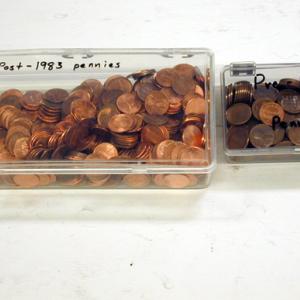College of Liberal Arts & Sciences
7D10.15 - Isotopes
Pre-1982 pennies have a mass of about 3.10 grams. The post-1983 pennies will have a mass of about 2.51 grams. Place some of each kind of penny into a container and weigh. Formulate a procedure to determine the amount of each isotope present.
- B. Cameron Reed, "Neutrons as Party Animals: An Analogy for Understanding Heavy-Element Fissility, TPT, Vol. 50, #9, Dec. 2012, p. 544.
- Ralph E. Weston, Jr., "A Boatload of Pennies", TPT, Vol. 40, #7, Oct. 2002, p. 392.
- Haym Kruglak, "Watch Your Pennies! - A Correction", TPT, Vol. 29, #5, May 1991, p. 262.
- Terrence P. Toepker, "More Physics Cents", TPT, Vol. 29, #8, Nov. 1991, p. 484.
- E. Scott Barr, "The Masses of Coins", TPT, Vol. 21, #6, Sept. 1983, p. 348.
- R.D. Edge, "The Author Replies: It's Not Simple", TPT, Vol. 21, #6, Sept. 1983, p. 348.
- Toni Feder, "Isotope Program Expands Activities", Physics Today, Vol. 68, #10, Oct. 2015, p. 20.
- Johanna Miller, "Isotope Ratios Hint at a Piece of Pristine Earth", Physics Today, Vol. 63, #10, Oct. 2010, p. 16.
- Phillip M. Walker and James J. Carroll, "Ups and Downs of Nuclear Isomers", Physics Today, Vol. 58, #6, June 2005, p. 39 - 44.
- William McNairy, "Baffling Buoyancy", 2008 AAPT/PIRA Apparatus Competition, An Entry for the Low Cost Category.
- Ramsey O. Benavides, "Independent Project: Two Chemistry Experiments on the Subject of Atomic Structure", Apr. 1996.
Disclaimer: These demonstrations are provided only for illustrative use by persons affiliated with The University of Iowa and only under the direction of a trained instructor or physicist. The University of Iowa is not responsible for demonstrations performed by those using their own equipment or who choose to use this reference material for their own purpose. The demonstrations included here are within the public domain and can be found in materials contained in libraries, bookstores, and through electronic sources. Performing all or any portion of any of these demonstrations, with or without revisions not depicted here entails inherent risks. These risks include, without limitation, bodily injury (and possibly death), including risks to health that may be temporary or permanent and that may exacerbate a pre-existing medical condition; and property loss or damage. Anyone performing any part of these demonstrations, even with revisions, knowingly and voluntarily assumes all risks associated with them.
